

Partner Carlton Alfred Willers, Dudley Huppler, Charles Lisanby, Billy Name, Robert Pincus-Witten, John Giorno, Jon Gould, Jed Johnson
Queer Places:
55 Beelen St, Pittsburgh, PA 15213
3252 Dawson St, Pittsburgh, PA 15213
Schenley High School, 4101 Bigelow Blvd, Pittsburgh, PA 15213
Carnegie Mellon University, 5000 Forbes Ave, Pittsburgh, PA 15213
33 Union Square E, New York, NY 10003
860 Broadway, New York, NY 10003
242 Lexington Ave, New York, NY 10016
1342 Lexington Ave, New York, NY 10128
158 Madison Ave, New York, NY 10016
Andy-Mat, 933 Madison Ave, New York, NY 10021
22 E 33rd St, New York, NY 10016
231 E 47th St, New York, NY 10017
57 E 66th St, New York, NY 10065
216 E 75th St, New York, NY 10021
159 E 87th St, New York, NY 10128
74 W 103rd St, New York, NY 10025
Eothen Compound, Ranch Rd, Montauk, NY 11954
St John the Baptist, Bethel Park, Pennsylvania, Stati Uniti
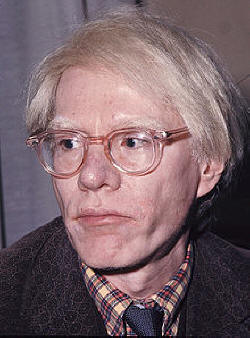 Andy Warhol [1]
(born Andrew
Warhola; August 6, 1928 – February 22, 1987) was an American
artist, director and producer who was a leading figure in the visual art movement known as pop art. His works explore
the relationship between artistic expression, celebrity culture, and
advertising that flourished by the 1960s, and span a variety of
media, including painting, silkscreening, photography, film, and
sculpture. Some of his best known works include the silkscreen paintings
''Campbell's Soup Cans'' (1962) and ''Marilyn Diptych'' (1962),
the experimental film ''Chelsea Girls'' (1966), and the multimedia events known as the ''Exploding Plastic Inevitable''
(1966–67).
Andy Warhol [1]
(born Andrew
Warhola; August 6, 1928 – February 22, 1987) was an American
artist, director and producer who was a leading figure in the visual art movement known as pop art. His works explore
the relationship between artistic expression, celebrity culture, and
advertising that flourished by the 1960s, and span a variety of
media, including painting, silkscreening, photography, film, and
sculpture. Some of his best known works include the silkscreen paintings
''Campbell's Soup Cans'' (1962) and ''Marilyn Diptych'' (1962),
the experimental film ''Chelsea Girls'' (1966), and the multimedia events known as the ''Exploding Plastic Inevitable''
(1966–67).
Born and raised in Pittsburgh, Warhol initially
pursued a successful career as a commercial illustrator. After
exhibiting his work in several galleries in the late
1950s, he began to receive recognition as an influential and
controversial artist. His New York studio, The
Factory, became a well-known gathering place that brought together
distinguished intellectuals, drag queens, playwrights, Bohemian street people, Hollywood celebrities, and
wealthy patrons. He promoted a collection of personalities known as Warhol superstars, and is credited with coining the widely used
expression "15 minutes of fame." In the late 1960s, he managed and
produced the experimental rock band The Velvet Underground and
founded ''Interview'' magazine. He authored
numerous books, including ''The Philosophy of Andy Warhol'' and
''Popism: The Warhol Sixties''. He lived openly as a gay man
before the gay liberation movement. After gallbladder surgery, Warhol died in February 1987 at the age of
58.
Warhol has been the subject of numerous retrospective exhibitions, books, and feature and
documentary films. The Andy Warhol Museum in his native city of
Pittsburgh, which holds an extensive permanent collection of art and
archives, is the largest museum in the United States dedicated to a
single artist. Many of his creations are very collectible and highly
valuable. The highest price ever paid for a Warhol painting is
US$105 million for a 1963 canvas titled ''Silver Car Crash
(Double Disaster)''; his works include some of the most expensive paintings ever sold.[2] A 2009
article in ''The Economist'' described Warhol as the "bellwether
of the art market".[3]
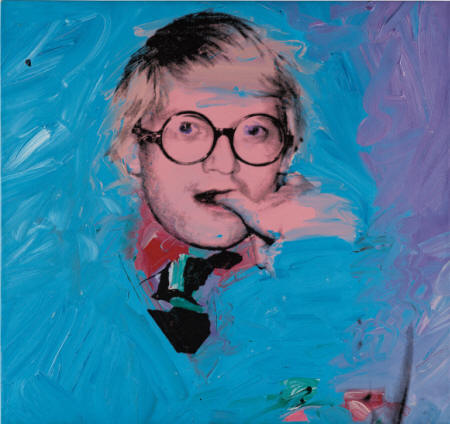
Andy Warhol, by
David Hockney
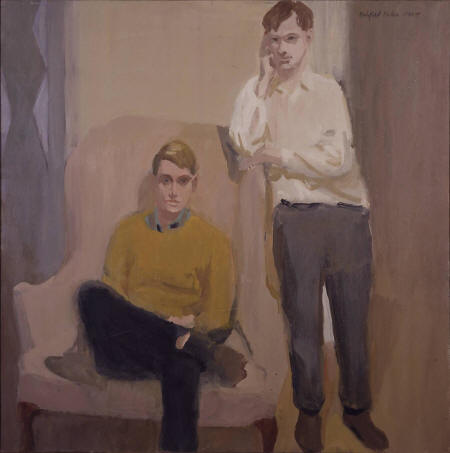
Fairfield Porter - Portrait of Ted Carey and Andy Warhol
![BILLY NAME [WILLIAM GEORGE LINICH] (1940-2016) Andy Warhol Working in The Factory.](http://www.elisarolle.com/images/images%20005/770708.jpg)
BILLY NAME [WILLIAM GEORGE LINICH] (1940-2016)
Andy Warhol Working in The Factory.
Silver print, the image measuring 235x184.2 mm; 9 1/4x7 1/4 inches, with a Linich Credit/Factory Photo hand stamp on verso. Circa 1965.
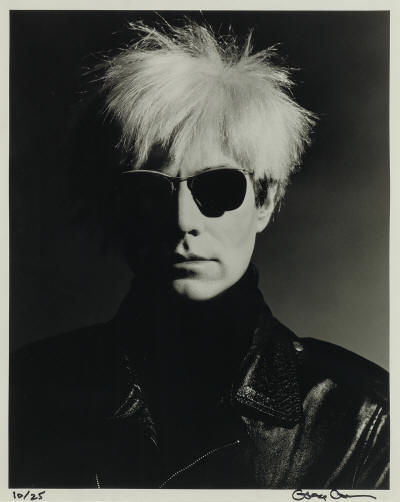
GREG GORMAN (1949 - )
Andy Warhol, Los Angeles.
Silver print, the image measuring 482x381 mm.; 19x15 inches, the sheet 508x406 mm.; 20x16 inches, with Gorman's signature and edition notation 10/25, in ink, on recto. 1986.

Among the men who caught Warhol's eye was author Truman Capote who he became obsessed with and began stalking. Pictured: American film producer Lester Persky with Warhol and Capote in 1978

Warhol was 'utterly immersed' in the gay community of Manhattan and one Halloween he turned up to a party wearing a garland of flowers, as 'daisy chain' was gay slang for a round robin orgy. Pictured: Warhol with Jerry Hall, Debbie Harry, Truman Capote and Paloma Picasso at Studio 54 circa 1970s

Warhol was 'utterly immersed' in the gay community of Manhattan and one Halloween he turned up to a party wearing a garland of flowers, as 'daisy chain' was gay slang for a round robin orgy. Pictured: Warhol with Jerry Hall, Debbie Harry, Truman Capote and Paloma Picasso at Studio 54 circa 1970s

Warhol's first proper lover, to whom he appears to have lost his virginity to, was a 20-year-old called Carlton Alfred Willers, who Warhol called' Willers'. Willers was a clerk at the picture collection of the New York Public Library and Gopnik writes the two men were 'intimate'. But Warhol was 'lousy in bed' as Willers described it, a description Warhol would be given by lovers 'for the rest of his life'. Pictured: Warhol at his art studio

One friend who knew Warhol in the 1950s remembered him saying: 'Oh, my bum is so sore because I met this number and he screwed the a** off me'. The friend didn't believe Warhol because he also had bought into the idea of him as asexual. Yet within a few years, Warhol was having surgery for anal warts and a tear, Gopnik writes. Pictured: Warhol with film director Paul Morissey, Viva and Gordon Locksley in 1968

That year he met Jed Johnson (pictured together), who would later become a famed interior designer, and the two stayed together for 12 years. At the time Johnson was a 19-year-old college kid from California who worked at The Factory fixing things up. He moved in with Warhol and they 'functioned as husband and husband' and appeared to have a full sexual relationship
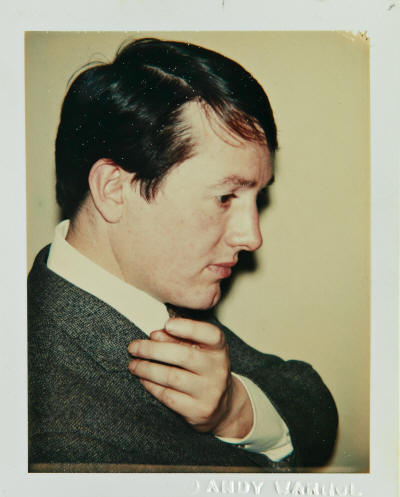
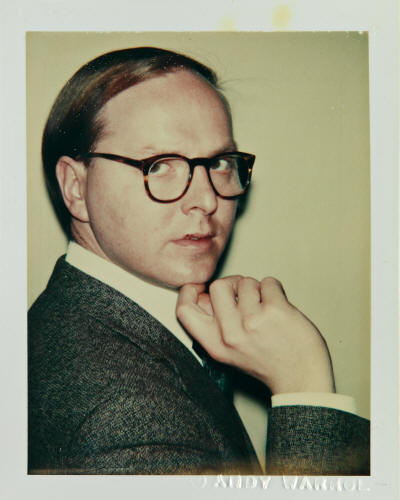
ANDY WARHOL (1928-1987)
A pair of portraits of the famed artist duo Gilbert & George.
Polaroids, the images measuring 95.3x73 mm; 3 3/4x2 7/8 inches, the sheets slightly larger, each with Warhol's embossed copyright blind stamp on recto. 1975.
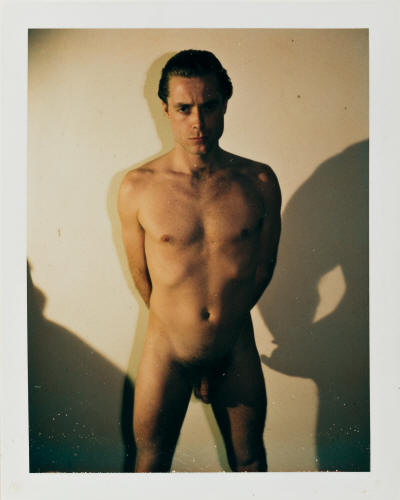
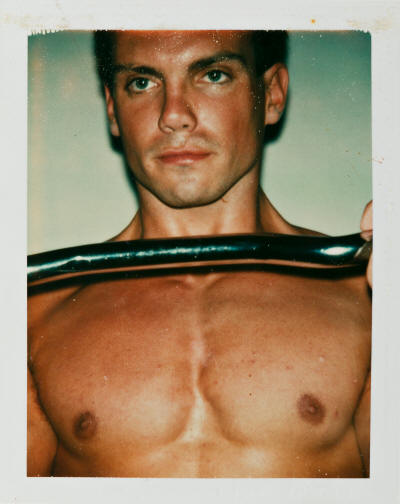
ANDY WARHOL (1928-1987)
A pair of portraits of Keith Peterson and Mike Walsh.
Polaroids, each image measuring 95x73 mm; 3 3/4x2 7/8 inches, the sheet 108x86 mm; 4 1/4x3 3/8 inches, the photograph of Keith Peterson with Warhol's embossed copyright blind stamp on recto. 1983-85.
This pair of photographs features body builder Keith Peterson and Warhol's studio assistant Mike Walsh. The images are reproduced in Barbara Hitchcock's "The Polaroid Book" (Taschen), where the image of Mike Walsh is erroneously dated 1977.
.jpg)
Joe Eula by Andy Warhol
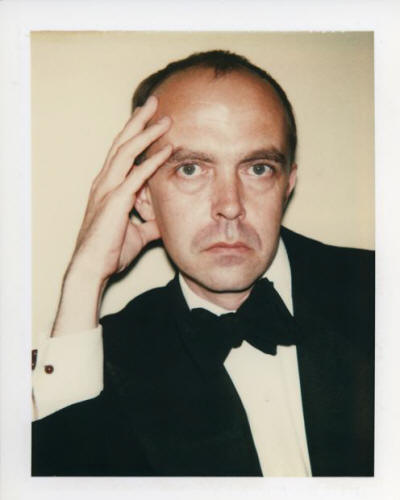
David Whitney by Andy Warhol
.jpg)
Hotel Chelsea, New York City
The Broad, Los Angeles
Vesuvius, Museo Nazionale di Capodimonte
Interviewed in 1980, Warhol
indicated that he was still a virgin—biographer Bob Colacello who
was present at the interview felt it was probably true and that what
little sex he had was probably "a mixture of voyeurism and masturbation—to use [Andy's] word ''abstract''".[6] Warhol's assertion of virginity would
seem to be contradicted by his hospital treatment in 1960 for condylomata, a sexually transmitted disease.[7] It has also been contradicted by his
lovers, including Warhol muse BillyBoy who has said they
had sex to orgasm: "When he wasn't being Andy Warhol and when you were
just alone with him he was an incredibly generous and very kind person.
What seduced me was the Andy Warhol who I saw alone. In fact when I was
with him in public he kind of got on my nerves….I'd say: 'You're just
obnoxious, I can't bear you."[8] Asked if Warhol was only a voyeur, Billy Name also
denied it, saying: "He was the essence of sexuality. It permeated
everything. Andy exuded it, along with his great artistic creativity….It
brought a joy to the whole art world in New York."[9] "But
his personality was so vulnerable that it became a defense to put up the
blank front."[10] Warhol's
lovers included John Giorno,[11] Billy Name,[12] Charles Lisanby,[13] and
Jon Gould. His boyfriend of
12 years was Jed Johnson, whom he met in
1968, and who later achieved fame as an interior designer.[14]
Warhol's first proper lover, to whom he appears to have lost his virginity to, was a 20-year-old called Carlton Alfred Willers, who Warhol called' Willers'. Willers was a clerk at the picture collection of the New York Public Library and Blake Gopnik, author of Warhol, writes the two men were 'intimate'. But Warhol was 'lousy in bed' as Willers described it, a description Warhol would be given by lovers 'for the rest of his life'. Willliers said Warhol was 'certainly not passionate, he was more passionate about food and eating'. Warhol's passions were for 'the beautiful people who owned and frequented certain restaurants', Gopnik writes. It took a lot of coaxing to have sex and Warhol could 'barely manage intimacy' said Willers, who revealed that occasionally during an 'intimate moment' when they were cuddling Warhol cried. Gopnik writes: 'He'd tell Willers that he's been thinking about something sad from his past, but it seems just as likely that Warhol had a depressive streak that few got to see - unless they looked closely at his art.'
Stephen Bruce, one of the founders of a popular Manhattan cafe called Serendipity, where Warhol became a regular, said he would fall under the spell of 'every attractive young man in the city, including me'. One such young man was Dudley Huppler, an artist from Wisconsin who was 11 years Warhol's junior and was close to Warhol for several years.
His next major lover was Charles Lisanby, a TV art director who later designed The Garry Moore Show, the comedy show that made a star of actress Carol Burnett. The relationship lasted for about ten years beginning in 1955. Warhol found himself drawn to Lisanby because he was tall, dark and from a 'horsey Southern family'. Gopnik writes the relationship 'hovered between a friendship, a flirtation and a love affair - depending on which of the two you asked to describe it'. Lisanby explained he 'didn't think Warhol wanted to have sex because it was 'messy'. Lisanby said: 'That was his word, it was too ''messy and distasteful''. He told me he'd had sex a few times, he had tried it and didn't really like it'. But Gopnik notes there is 'plenty of evidence' that Warhol enjoyed 'all kinds of erotic contact in those early years and over the course of his life'. Even Lisanby said when it came to sexual function, Warhol was 'normal in all respects'.
Ted Carey was a painter, designer, collector, author, and teacher. Known to his friends as "Ted," he is best remembered as a prominent collaborator, studio assistant, shopping partner, and possible one-time lover of Andy Warhol. According to the same Carey: "I think, I met Andy in the late 1950s. It was around 1957. I think it was around 1957... as I remember, I met Andy at an exhibition of drawings he had done. And the exhibition was at Serendipity... And this particular exhibition was an exhibition of drawings of cats. And I think that the title of the show was 'Cats with Hats'... And that was the first time I had met him, and then I saw him shortly after that in the zoo... in the cafeteria of the zoo. And he had remembered meeting me. And he said he would like me to pose for him. So, at that meeting we made a date, and he came by and did one or two drawings of me... At that time, I think I was working for N.B.C. And shortly after that I lost my job at N.B.C. I was unemployed."
Another of Warhol's lovers was Billy Name, aka William George Linich, who was a photographer and archivist at The Factory, Warhol's infamous work and party space in Manhattan. Name became Warhol's 'pet' and Warhol would sent him notes saying: 'My mother told me to pick the very best one. I pick you.' The two were briefly lovers but were 'very awkward and very shy about the whole sexual thing', Name said. Name said if he put his hand on Warhol's shoulder, he would jump as another lover said that Warhol was 'so feather-light that it sent one lover into ecstatics'.
One of Warhol's other boyfriends was Robert Pincus-Witten who appeared in Warhol's film The 13 Most Beautiful Boys. Pincus-Witten was a 19-year-old who admitted he was a 'star f**ker' and sought out Warhol at The Factory. Like many of Warhol's lovers, Pincus-Witten said the sex was 'bad and awkward, even absurd' and didn't last very long. But Warhol did give him one thing - crabs, the sexually transmitted disease. Pincus-Witten joked that if the pests didn't come from the couch at The Factory then it was from 'Andy's crotch'.
In 1968 Warhol survived an assassination attempt by radical feminist writer Valerie Solanas, leaving him with deep scars from the bullet wounds. That year he met Jed Johnson, who would later become a famed interior designer, and the two stayed together for 12 years. At the time Johnson was a 19-year-old college kid from California who worked at The Factory fixing things up. He moved in with Warhol and they 'functioned as husband and husband' and appeared to have a full sexual relationship. A friend recalled a time when someone denied another gay couple were lovers, with Warhol saying: 'That would be like saying Jed and I were just friends'. The friend added: 'Believe me, they were lovers'. Jonson confirmed this to a friend later and said sex with Warhol was 'at a schoolboy level'. In public they did not display any affection and Warhol could be a jealous and controlling partner, in no small part due to the attempt on his life. The relationship lasted until 1980, by which time Warhol was partying at Studio 54 where he 'couldn't keep his eyes, or his thoughts, or sometimes his hands, off the gorgeous young lads he saw on the dance floor most nights'. In a farewell note Johnson told Warhol: 'I don't think you'll get (what you're looking for) from your Victors and Kevins and nights at Studio 54. You did have all my love and respect. Sorry it went wrong.'
The fact that Warhol's homosexuality influenced his work
and shaped his relationship to the art world is a major subject of
scholarship on the artist and is an issue that Warhol himself addressed
in interviews, in conversation with his contemporaries, and in his
publications (''e.g.'', ''Popism: The Warhol 1960s''). Throughout his
career, Warhol produced erotic photography and drawings of male nudes.
Many of his most famous works (portraits of Liza Minnelli, Judy
Garland, and Elizabeth Taylor, and films such as ''Blow Job'', ''My Hustler'' and ''Lonesome Cowboys'') draw from gay underground culture or openly
explore the complexity of sexuality and desire. As has been addressed by
a range of scholars, many of his films premiered in gay porn
theaters.[15]
The first works that
Warhol submitted to a fine art gallery, homoerotic drawings of male
nudes, were rejected for being too openly gay.[16] In
''Popism'', furthermore, the artist recalls a conversation with the film
maker Emile de Antonio about the difficulty Warhol had being
accepted socially by the then-more-famous (but closeted) gay artists
Jasper Johns and
Robert Rauschenberg. De Antonio explained that
Warhol was "too swish and that upsets them." In response to this, Warhol
writes, "There was nothing I could say to that. It was all too true. So
I decided I just wasn't going to care, because those were all the things
that I didn't want to change anyway, that I didn't think I 'should' want
to change ... Other people could change their attitudes but not
me".[17][18] In
exploring Warhol's biography, many turn to this period—the late 1950s
and early 1960s—as a key moment in the development of his persona. Some
have suggested that his frequent refusal to comment on his work, to
speak about himself (confining himself in interviews to responses like
"Um, no" and "Um, yes", and often allowing others to speak for him)—and
even the evolution of his pop style—can be traced to the years when
Warhol was first dismissed by the inner circles of the New York art
world.[19]
My published books: